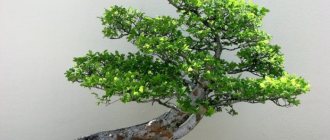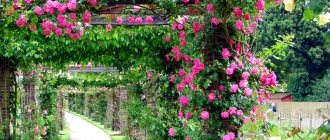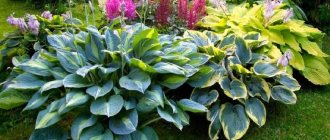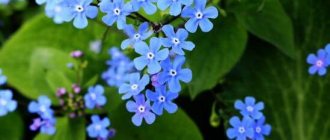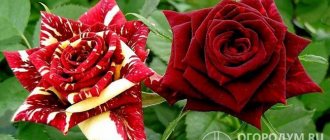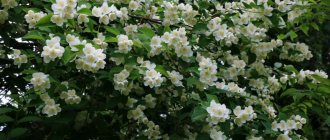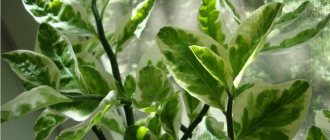Garden climbing plants are popular among flower growers of all countries due to their decorativeness and diversity. Landscape designers use them to decorate walls and facades of buildings, gazebos, fences, balconies, and terraces. They are able to hide defects in old buildings and barns.
Lianas allow you to radically change the appearance of the site, creating areas of increased coziness and comfort. With their help, they form magnificent compositions that attract everyone's attention.
General information
A feature of climbing garden vines is their thin stem, which does not allow them to hold massive foliage vertically. Ornamental vines for the garden adapt to survival by attaching to vertical supports with tendrils, suckers, shoots, thorns and auxiliary roots.
Lianas originate from the tropics and subtropical countries of Africa, Asia and America, but have long been acclimatized not only on European territory, but also in the harsh Siberian and Far Eastern conditions. Photos of vines for the garden delight all lovers.
There are many varieties of climbing plants, which are usually classified into two broad categories: annuals and perennials. Both groups include decorative and fruit-bearing varieties.
Location on the site
Liana-like plants do well on the sunny side. It is better to plant them in well-drained soil. If crops are planned to be placed along the walls of a house, they should not be rooted close to the building so that the foundation does not interfere with the development of shrubs. The ideal distance for indentation is 50 cm.
In the first years, perennial garden vines will have to be supported from wooden posts or metal rods. The shoots are tied with thin pieces of fabric so as not to damage the stem. As they develop, flowering vines cover a wall or fence, and it turns into a real work of landscape design.
Annual vines
There are more than a hundred varieties of climbing plants with a lifespan of one season. They are all different in appearance and other features, but they are distinguished by common characteristics, for example, a long stem with missing side shoots. They usually weave around hedges, terraces, and walls in well-lit places. Lianas are light-loving; they require enough light for normal development.
At the planting site, the soil must be thoroughly dug up. Annuals are planted annually. They have the ability to scatter seeds around and displace nearby flowers. The owner of the site has to ensure that this does not happen.
Examples in the interior
As mentioned above, climbing plants can become a real decoration of the interior, making it more attractive, lively and expressive. Let's look at some successful examples of using vines at home.
Lush growing climbing plants can make a very stylish living room interior if you install them on both sides of the sofa on the wall behind. Plants will attract more attention if they are surrounded by light-colored finishing materials.
Indoor vines with thin and graceful stems can be hung as window decorations in a bright room with wood and glass furniture.
To learn how to give a different shape to the scindapsus vine, see the following video.
Classification of annuals
This type includes:
- Echinocystis, popularly called “mad cucumber” and until recently considered a weed;
- sweet pea, a bindweed from the legume family with an attractive scent and bright colors;
- Basella alba, or Malabar spinach, which has medicinal properties and is eaten in southeast Asia;
- dolichos, a vine from the legume family, reaching 3 meters in length, characterized by rapid growth, unpretentiousness and decorativeness;
- climbing kobeya with bell-shaped flowers;
- nasturtium with large fragrant flowers of bright orange color and rounded leaves;
- quamoclite, an unpretentious annual from which Christmas tree figures are formed;
- rough ellipse, beautifully blooming with bright buds from mid-summer to the end of the autumn season;
- azarina, or maurandia, which blooms for several months;
- thunbergia with heart-shaped leaves and large 5-centimeter flowers in snow-white, beige and other colors with a dark center.
Many flowering vines for the garden in their homeland, in the tropics, grow for more than one year, but in our climate, gardeners plant them as annuals.
climbing rose
Well, what is a garden without a queen? The perennial climbing flower, captivating with the perfection of its buds and sweet aroma, has deservedly received a high title. The Becker online store has received hot hits - varieties Mont Blanc, Golden Carpet, Lavinia, Climbing, Pink Pearl, Blue Dream. If you want to choose a worthy companion for climbing roses, then read the article on how to make friends with the lady of the garden and clematis.
For those who do not know how to plant roses, it will be useful to watch detailed video instructions from our expert:
Planting and caring for annual vines
When planting vines, it is necessary to take care of vertical supports, which can be pegs, branches, fences, and netting. It is advisable to install stands at the time of planting, so as not to later injure the roots of the sprouted plant. Caring for annual vines involves removing shoots that look out of place.
Annuals are capable of growing 5 meters in height in a short period of time. They are grown by seedlings and seed methods. Transplantation of seedlings into open ground occurs after the end of the threat of frost, in the second ten days of May.
Seeds sown in the soil should be covered with film, and when the first true leaves appear, pinching should be done to form new shoots.
Advanced gardeners often use perennials for propagation as annuals. The specificity of the technique is to get rid of unnecessary worries about wintering and at the same time the desire to vary the appearance of the site every season.
Tatarian honeysuckle
Tatar honeysuckle comes from the harsh northern regions, and this explains its unpretentiousness and “survivability”. She doesn’t mind frosts, lack of sunlight, droughts or even soil salinity.
This northern beauty is covered with flowers in late May - early spring, depending on climatic and weather conditions. Flowering lasts on average about 2 weeks. This vine blooms for the first time in the third year of life.
Propagating honeysuckle of this species is as easy as shelling pears: almost half of the seeds consistently germinate, and green summer cuttings take root in 100% of cases. In addition, Tatarian honeysuckle is not at all afraid of transplants. Even an inexperienced gardener can handle caring for this plant.
| Vine length (m) | Flowering time | Soil type | Peculiarities |
| 3-4 | Late May – mid July | Any | Frost resistance, 100% rooting of summer cuttings, susceptibility of young shoots to aphids and viruses |
Classification of perennial varieties
Climbing vines are grouped into two categories: woody and herbaceous. The first of them continue to grow every spring from where they left off last year, increasing in length and multiplying foliage and flowers. The trunk becomes harder over time, resembling wood. The latter, if they do not fall off on their own, need pruning to ground level. In the spring, this root will sprout new shoots.
Tree crops are frost-resistant and not resistant to winter cold. They can withstand winter frosts well and do not need to be removed from their supports for the winter and covered.
In extreme frosts, the maximum damage that the weather can cause to them is the freezing of young branches. Cold-resistant vines require insulation.
Types of perennial lianas:
- a climbing rose that evokes the admiration and delight of lovers;
- Kampsis, which is called the “sleeping beauty”, with amazing gramophone flowers;
- beautiful vines are not a compliment, but the name of a variety of perennial climbing plant;
- actinidia with foliage that turns red in autumn and winter orange berries;
- girlish grapes, which wonderfully green up walls and hedges, changing the color of the foliage to burgundy by the end of the season;
- honeysuckle with an attractive aroma and edible fruits for butterflies;
- ivy is the most common garden vine, creating a continuous carpet of foliage;
- clematis with flowers of various colors, rivaling roses in beauty;
- wisteria, characterized by the density of flowers, due to which the leaves are not even visible;
- bougainvillea with delightful flowers and creeping shoots.
Among the perennial climbing plants there are ordinary vines, found everywhere, simple-minded and unassuming, not requiring much effort in care. More experienced gardeners take on the task of planting exotic plants that are adapted to our weather and deserve attention.
There are a huge number of wonderful weaving garden vines that allow you to transform a site and hide all its defects, create corners of comfort and joy in the garden.
Rolled lawn on site- How to choose a drilling company: top 5 tips from experts
Cleaning the beds
Honeysuckle Honeysuckle
This fragrant, spectacular vine loves the sun, but can also tolerate partial shade. It reaches its maximum size after 5-6 years of life.
Honeysuckle honeysuckle is not picky about soil acidity, but prefers areas with fertile, well-drained soil. Liana can withstand frosts down to –25°C. Propagated by cuttings, seeds and layering.
Honeysuckle honeysuckle is one of the most traditional vines for pergolas and gazebos. During flowering, it attracts a huge number of butterflies and bees and fills the garden with a pleasant aroma.
| Vine length (m) | Flowering time | Soil type | Peculiarities |
| 4-8 | Late May – mid July | Fertile, moist, loose | For good flowering, formative pruning is required in March-April. |
Proper watering
House vines require moderate watering, which should be repeated as the soil dries out. You cannot flood the flower, as this will lead to rotting of its root system. Therefore, 15-20 minutes after the end of watering, it is necessary to check the pan and drain the water collected in it.
It is best to moisten the flower in the morning or evening, but it is important not to flood the base of the shoots and leaves. The water should be warm (temperature above room temperature) and settled. You can also use bottled water.
Shade-loving
Plants planted along fences and house walls often end up in the shade. To create a hedge, you should choose specimens that are not demanding of sunlight. Such vines may not be distinguished by lush flowering, but they are strong and unpretentious and do not require careful care.
Akebia
The second name of this crop is chocolate rose. The heat-loving plant has recently begun to be grown in the northern regions. The length of the vine branches reaches 10 m. The culture is frost-resistant and can overwinter at -20 degrees.
Chocolate rose buds are three-petalled, round in shape. Their shade is dark purple, close to chocolate. The buds are collected in small racemose inflorescences. Akebia looks best against the wall of the house.
Hydrangea petiolate
This is a powerful tree-like vine with short aerial roots and strong lateral shoots. It arrived in Europe from the Far East and took root well in the northern regions. It grows quickly, is frost-resistant, but requires moisture. If the area is dry, it is better to plant it in the shade.
The flowers are small, creamy-white, collected in corymbose inflorescences up to 20 cm in diameter. They appear in July. Flowering ends at the end of August. The plant looks beautiful as a hedge decorating the walls of houses, gazebos, pillars, and old withered trees.
Interesting! What are hydrangeas?
Dolichos purple
An annual branching vine known by many names. The most popular are decorative beans, Egyptian beans, and lobia. In hot climates, the crop behaves as a perennial.
Related article:
Schisandra plant: photos, types, cultivation, planting and care
Dolichos has heart-shaped leaves. They come in purple, violet or green. The inflorescences collected from small white, crimson or pink flowers are not inferior to them in beauty. One inflorescence can contain up to 40 buds.
One flower lives only 2-3 days, but the brush can please the eye for a month. When it fades, dark lilac pods similar to beans appear in this place. They can be up to 11 cm in length. One brush produces from 5 to 15 pods. They perform a purely decorative function and are not eaten.
Sweet pea
If you need to decorate a low hedge, you can use sweet peas. The herbaceous annual crop is extremely unpretentious, takes root equally well in the shade and in sunny areas, and does not require abundant watering or frequent fertilizing.
The plant is distinguished by small oblong leaves and green tendrils with which the peas cling to the supports. It blooms almost continuously starting in spring. Small, oddly shaped pink, lilac or white buds appear on grassy shoots, emitting a delicate aroma.
Honeysuckle
A climbing shrub, widespread in the northern regions of Russia. It also grows in the Himalayas and East Asia. The culture is a deciduous plant with thin stems up to 3 m long, which are distinguished by a light purple tint and edge.
Honeysuckle blooms quite early. Small tubular buds with large stamens are collected in inflorescences of several pieces. The shade depends on the chosen variety: from white to yellow and bright red. In June-July, small blue berries ripen in place of the flowers and are very tasty. They are suitable for making jam, compotes, and desserts.
Honeysuckle is afraid of frost. For the winter, it is lowered and covered so that the sprouts do not freeze. In autumn, excess shoots are trimmed to allow light to reach the inner stems. Old creeping branches are also removed before the onset of frost.
climbing rose
The plant can be planted both in the shade and in sunny areas. The culture is distinguished by delicate inflorescences of a pleasant scarlet or purple hue and an amazing aroma. Flowering begins in June and continues until the end of October.
Related article:
Work in the flower garden in August
The rose is quite whimsical, so the gardener will have to be patient. The crop should not be placed on metal supports, as it may freeze in winter. A wooden fence is best. In late autumn, the plant is wrapped in film, and the soil around the trunk is covered with sawdust. Dead stems are pruned in the spring, and major pruning is carried out every 3 years, which helps extend the life of the branches.
